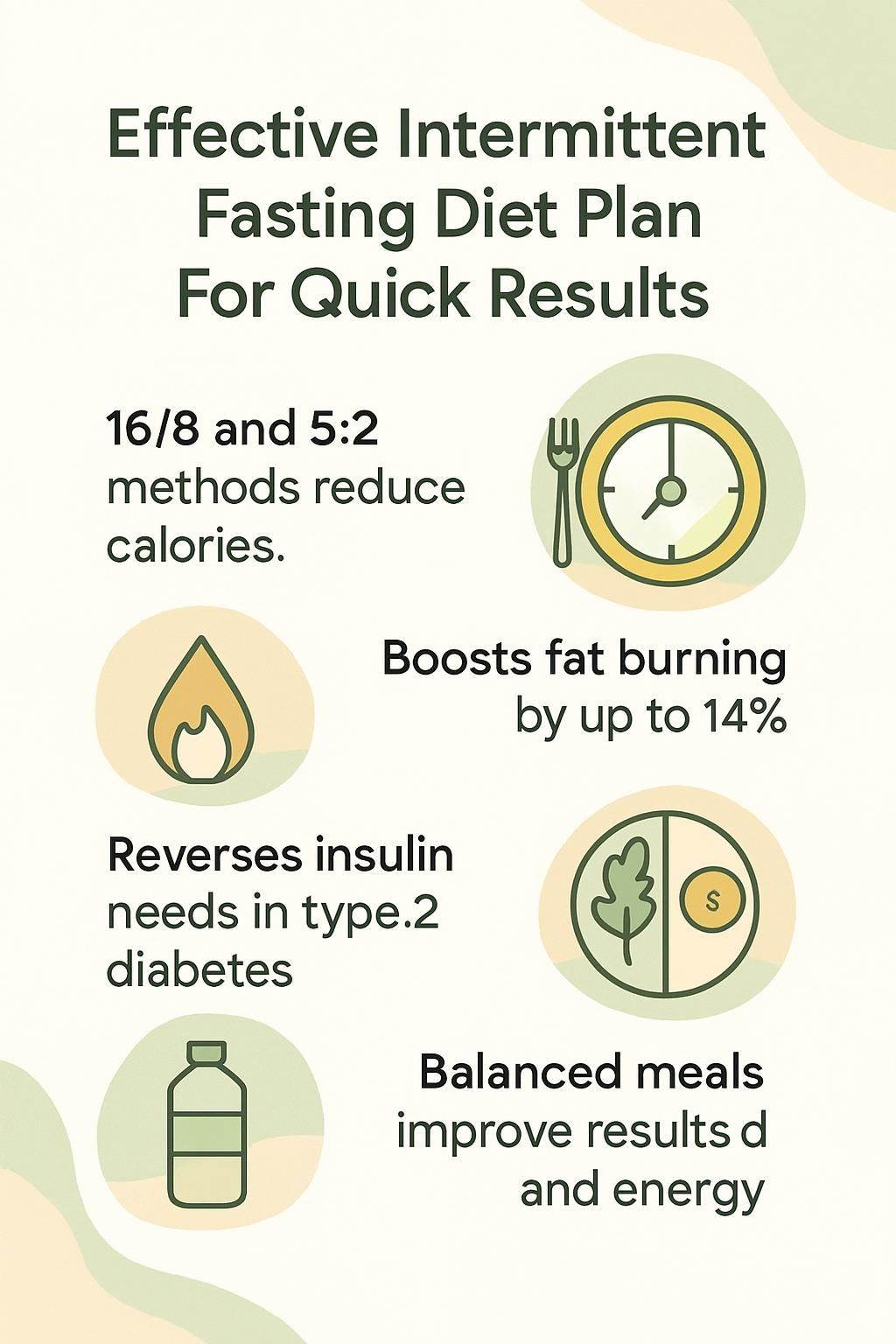Effective Intermittent Fasting Diet Plan For Quick Results
Our Nutrition Assistant AI Suite will transform your body. You will lose fat, get toned, and build muscle. Gain confidence and optimal health.
Frustrated with diets that stall out? Intermittent fasting can help you cut calories, burn fat, and feel more in control. You focus on when you eat, not only what you eat, which can make weight management simpler.
This guide explains how intermittent fasting works, the benefits you can expect, and a simple meal plan you can start today. You will also learn safe fasting schedules, hydration tips, and who should talk with a doctor first.
Key Takeaways
- Popular schedules like 16/8 and 5:2 reduce total calories and support weight loss, with positive effects on metabolic health shown in human studies.
- Research reports lower insulin, glucose, leptin, and LDL cholesterol with intermittent fasting. Inflammation markers, such as C-reactive protein, also tend to drop.
- Some people with type 2 diabetes lowered or paused insulin use under close medical care while using intermittent fasting.
- Balanced meals with lean protein, whole grains, vegetables, and healthy fats improve results and reduce the chances of fatigue or nutrient gaps.
- Track meal timing, hydration, and sleep with an app for better consistency. People with chronic conditions should ask a doctor before they start.

What is Intermittent Fasting?

Intermittent fasting is an eating pattern that sets clear times for eating and fasting. You center your plan on timing, which can affect hunger, hormones, and calorie balance.
What does intermittent fasting mean?
Intermittent fasting focuses on when you eat instead of only what you eat. You cycle between fasting and eating. A common example is 16/8, which means you fast for 16 hours and eat all meals in an 8-hour window.
The 5:2 approach is different. You eat as usual 5 days per week, then limit yourself to about 500 to 600 calories on 2 nonconsecutive days. This pattern reduces weekly calories while keeping most days flexible.
Scientists think this style may fit human biology because food was not always available in the past. In my first month of fasting, I stopped late-night snacking and felt steadier during the day.
How does intermittent fasting work?
Shortening your eating window usually lowers your total calories. During the fast, your body uses stored energy from body fat instead of calories from recent meals. That shift can support fat loss over time.
Studies show fasting lowers insulin, glucose, and leptin. These changes can make it easier for your body to release stored fat. Most people notice more hunger or mood swings during the first two to four weeks while the body adapts.
Fasting can improve insulin resistance, which means cells respond better to insulin. Very long fasts, more than a day, may activate a stress response. That can backfire if you overdo it or feel weak.
In my case, the first week felt tiring. By week three, energy improved, and mornings were easier. Drink water, and be patient as your routine settles in.
Benefits of Intermittent Fasting
Many people try fasting for weight control and health. The benefits touch weight, blood sugar, inflammation, and energy.
How does intermittent fasting help with weight loss and fat burning?
Fasting makes it easier to eat fewer calories by shrinking your eating window. A review of fasting regimens found weight loss across most plans. In one study with young men, a 16-hour fast increased fat burning while holding muscle.
Fewer hours to eat can help you keep a calorie deficit. That is still the key for weight loss. Some research shows similar results when compared with standard calorie restriction. Weight regain can happen if old habits return, so consistency matters.
Plan your meals, keep portions smart, and aim for a steady schedule. That makes this approach easier to maintain.
Can intermittent fasting improve insulin sensitivity?
Yes. Many studies show lower fasting glucose, insulin, and leptin during intermittent fasting. In a 2018 report, some people with type 2 diabetes were able to stop insulin under medical supervision while fasting.
Postmenopausal adults also report better blood sugar control with steady schedules. When I tested a 16-hour fast for three months, my fasting glucose improved on routine labs.
My morning sugar dropped by about 10 points after I stuck with a simple fasting plan,shared one reader who tested a few different schedules.
How does intermittent fasting boost metabolism?
Fasting can raise norepinephrine, a hormone that helps move fat into the bloodstream for energy. It also encourages the body to use stored fat during longer fasting periods.
Some animal studies show higher adiponectin during fasting. Adiponectin is a hormone that supports insulin sensitivity and energy use. Small trials suggest higher fat burning during intermittent fasting compared with long, strict calorie cuts.
From my experience with 16/8, I felt steady energy and saw slow, steady weight loss. Avoid extreme calorie cuts during your eating window. Eating too little for too long can slow your metabolism.
Does intermittent fasting reduce inflammation?
Research links intermittent fasting with lower inflammation markers, such as C-reactive protein and interleukin-6. That shift may support heart health and general recovery.
Improvements in blood pressure, LDL cholesterol, and triglycerides also appear in several trials. HDL, the so-called good cholesterol, may rise. After a month on 16/8, my cholesterol panel looked better than the prior visit.
Can intermittent fasting increase energy levels?
Energy often dips during the first two to four weeks. After that, many people report feeling sharper and more alert. The body adapts by tapping stored fat, which can support steadier energy.
Fasting may raise norepinephrine, which supports focus. Eating inside a set window also helps reduce blood sugar spikes from sweets and refined snacks.
Better meal quality and less processed food can improve sleep and cut afternoon slumps. Pick a schedule that fits your day so you can stick with it.
How does intermittent fasting promote cellular repair and longevity?
Fasting triggers autophagy, which is a clean-up process where cells recycle old or damaged parts. That process helps protect cells from stress over time.
Animal studies suggest fasting can improve recovery and extend lifespan under certain conditions. During fasting, insulin falls and the body shifts from glucose to stored fat. That shift appears to boost autophagy.
Human data is growing. I used a 16/8 schedule for several months and felt more energetic. My meals shifted toward whole grains and produce, which made the plan easier to follow.
Types of Intermittent Fasting
Choose a method that matches your routine and goals. A good fit is the best predictor of success.
16/8 method
The 16/8 method means fasting for 16 hours and eating for 8 hours daily. Many people eat from noon to 8 p.m. because it works with work and family meals.
This plan is flexible and fits most schedules. Benefits can include weight loss and better blood sugar control. You can repeat it one to seven days per week. Healthy adults often do well with 16/8, but check with a doctor if you have diabetes, take insulin, have high or low blood pressure, or a history of disordered eating.
5:2 method
With 5:2, you eat as usual five days per week. On two nonconsecutive days, you eat about 500 to 600 calories. Many choose Monday and Thursday.
This pattern cuts weekly calories without daily restriction. People with high cholesterol sometimes see better lipid results over time. Many report fewer headaches and more energy compared with daily calorie cuts.
Alternate-day fasting
Alternate-day fasting means you eat normally one day, then fast or limit to about 500 calories the next. Research in animals links this pattern with better endurance and tissue health.
I tried this during a busy work season. On low-calorie days, I leaned on water, tea, vegetables, and lean protein. It simplified planning and kept my intake steady. Speak with your doctor first if you use insulin or have type 1 diabetes, arthritis, or other medical conditions.
Eat-stop-eat method
Eat-stop-eat asks you to fast for 24 hours once or twice per week. For instance, stop at 7 p.m., then eat again at 7 p.m. the next day.
This is an advanced method, not ideal for beginners. Longer fasts can raise the risk of low blood sugar, weakness, and stress on the body. Extended fasts of 24 to 72 hours can also trigger a starvation response that may slow fat loss.
Experts suggest most people do not need very long fasts to see results. Talk with your doctor before any big change in eating, especially if you are managing menopause symptoms, schizophrenia, or need insulin.
1: “Effects of Intermittent Fasting on Health Markers” (New England Journal of Medicine)
2: “Is Extended Fasting Safe?” Harvard Health Publishing
3: National Institute of Diabetes and Digestive and Kidney Diseases
Warrior diet
The Warrior Diet allows small amounts of raw fruits and vegetables during the day, then one large meal at night inside a 4-hour window. It is inspired by a feast-later style.
This plan can feel strict because the eating window is short. Some people lose weight faster, while others feel tired by late afternoon. I tried it with light daytime produce and a protein-and-grain dinner. The first week felt hard, though bloating eased over time.
Intermittent fasting is generally safe for healthy adults, but this version is not for everyone. Discuss your plan with your doctor if you have medical conditions or worry about weight regain.
How to Start Intermittent Fasting
You can make fasting fit your life. A simple schedule, basic tracking, and steady hydration can set you up for wins.
How do I choose the right fasting schedule?
Pick a schedule that fits your day. Many beginners start with 16/8 and use a noon to 8 p.m. window. That keeps lunch and dinner social and easy.
You can also try 7 a.m. to 3 p.m., 9 a.m. to 5 p.m., or 2 p.m. to 10 p.m. Start with shorter fasts and increase slowly. Use a mobile app to log meals and watch calories and carbs.
When I tested different windows, realistic targets reduced stress and made the routine easier to keep.
How can I align intermittent fasting with my lifestyle?
Choose a window around your work, family, and exercise. The 16/8 method is flexible and can match sports or shift work. If you fast in the morning, plain coffee or tea without cream or sugar is fine.
Fasting can save time and money since you prep fewer meals. For longer fasts like eat-stop-eat, pick low-stress days. As a full-time parent, I moved dinner earlier. That allowed a longer overnight fast and easier family time.
Flexible plans like 16/8 show better adherence in research. Drink water throughout the day to support energy and focus.
Why is staying hydrated important during fasting?
Hydration prevents headaches, fatigue, and dizziness during fasting. Water, unsweetened tea, and black coffee work well because they have almost no calories.
For longer fasts, a pinch of salt in water can help maintain electrolytes. Dehydration can affect thinking and may worsen cholesterol in some adults. Staying hydrated also supports fat loss by keeping metabolism efficient.
Effective Intermittent Fasting Diet Plan
This sample plan focuses on whole foods, steady energy, and quick wins you can feel.
Day 1
- Start your day with water or plain coffee during the fast. Hydration supports energy and focus.
- Break your fast with a grilled chicken summer salad with strawberries, tomatoes, feta, almonds, and avocado. Use a light honey Dijon vinaigrette.
- Lean protein and healthy fats help you feel full. They support metabolism and recovery.
- For dinner, enjoy baked salmon with crispy onions and zucchini. Add quinoa or brown rice if you need more calories.
- Aim for modest portions at both meals. Adjust serving sizes based on age, size, and activity.
- Choose whole foods during your eating window. Research shows fasting can reduce inflammation markers when quality is high.
- Meal prep reduces temptation to snack outside your window.
- Fiber from produce and grains supports digestion and steadier blood sugar.
- Track your energy and hunger. Many people feel better after the first two weeks.
- Consistent habits support long-term health and can improve your day-to-day resilience.
Lunch: Grilled chicken summer salad with honey Dijon vinaigrette
Grilled chicken adds lean protein that keeps you full. Avocado and almonds supply healthy fats for steady energy.
Strawberries and tomatoes bring antioxidants and color. Feta adds flavor and calcium with a modest calorie cost.
Toss with a homemade honey Dijon vinaigrette. Keep the dressing light to manage calories. This is a nutrient-dense lunch that fits nicely in most intermittent fasting meal plans.
Dinner: Baked salmon with crispy onions, zucchini, and quinoa
Salmon provides omega-3 fats that support heart health and may help reduce inflammation. Roast zucchini for fiber, then add quinoa for complex carbohydrates.
Brown rice works too if you prefer a different grain. Balanced plates like this make fasting easier because they satisfy without leaving you sluggish at night.
Portion sizes drive total calories. Adjust based on hunger, exercise, and goals.
Day 2
- Breakfast: Greek yogurt with fresh fruit and granola. You get protein, calcium, and fiber.
- Lunch: Vegan vegetable and herb soup with crusty bread. Plants add vitamins, minerals, and volume.
- Dinner: Stir-fried chicken with vegetables and brown rice. Protein and fiber support fullness.
- Hydration: Aim for about eight cups of water across your eating window, then sip during the fast as needed.
- Portions: Stick to moderate portions. Smaller plates can help you keep calories in range.
- Real-life example: On my second day, whole foods kept me full and reduced snack urges.
- Track: Use an app or journal to spot patterns that help you stay consistent.
Breakfast: Greek yogurt with fresh fruit and granola
Greek yogurt delivers 10 or more grams of protein per serving, plus probiotics for gut health. Fresh berries or banana add vitamins and natural sweetness. A small handful of granola provides crunch and extra fiber.
This combo balances protein, dairy, complex carbs, and fiber. It is quick to prepare and keeps energy steady until lunch.
- Calories: about 300 to 400
- Protein: 15 to 18 grams
- Calcium: up to 20 percent DV
- Fiber: 4 to 6 grams
Lunch: Vegan vegetable and herb soup with crusty bread
A hearty vegetable and herb soup offers vitamins A and C, potassium, and plant compounds that support your immune system. Fresh herbs add flavor and antioxidants.
Crusty bread brings complex carbs for lasting energy. This meal is filling, low in saturated fat, and easy to batch cook.
Dinner: Stir-fried chicken with fresh veggies and brown rice
Stir-fried chicken breast adds about 27 grams of protein per 3-ounce serving. Bell peppers and broccoli supply vitamin C, potassium, and antioxidants.
One cup of brown rice adds around 3.5 grams of fiber. The meal keeps blood sugar steadier because it digests slowly. It is satisfying without feeling heavy before bed.
Day 3
Focus on whole grains, beans, and colorful vegetables. These meals bring fiber and protein that support fasting hours.
- Breakfast: Whole grain toast with eggs, red pepper flakes, cilantro, and a squeeze of lime.
- Lunch: Chickpea and cucumber salad with parsley and red bell pepper.
- Dinner: Black bean chili with salsa and avocado.
- Hydration: Keep water or herbal tea nearby. Sip through the day.
- Limit snacks: Focus on nutrients first to support weight loss goals.
- Watch portions: Enough food to feel satisfied, not stuffed.
- Color matters: Aim for multiple colors to boost antioxidants.
- Shop ahead: Stock beans, grains, and produce to stay on track.
- Journal: Note what meals keep you full or trigger cravings.
Breakfast: Whole grain toast with eggs, red pepper flakes, and lime juice
Place two eggs on whole grain toast. Sprinkle red pepper flakes and chopped cilantro, then add fresh lime juice.
Eggs offer protein for muscle repair. Whole grain bread brings fiber for fullness. Lime adds vitamin C, and red pepper offers a mild boost to metabolism through capsaicin.
Lunch: Chickpea and cucumber salad with parsley
Combine chickpeas, diced cucumber, red bell pepper, and parsley. One cup of chickpeas provides about 14 grams of protein and a strong dose of fiber.
Bell pepper adds vitamin C. Cucumber boosts hydration. Parsley brings flavor and vitamins K and A. This salad is satisfying and keeps energy steady.
Dinner: Black bean chili with salsa and avocado
Cook black beans with chili powder and salsa for a quick, bold dinner. Top with sliced avocado for healthy fats and extra fiber.
One cup of black beans has about 15 grams of protein and 15 grams of fiber. Avocado adds potassium and monounsaturated fat, which supports fullness and heart health.
Lime juice and cilantro make it bright. It is a great fit for evening meals before your fast resumes.
Tips for Success with Intermittent Fasting
Small, steady habits create results. Use these ideas to make your plan easier to keep.
How can I avoid processed foods during eating windows?
Plan your meals and shop for whole foods first. Choose fruits, vegetables, nuts, lean meats, beans, and whole grains. Skip sugary drinks and deep-fried snacks.
I had fewer cravings once I cleared my pantry and kept water and tea on hand. Research links higher whole food intake with better long-term health compared with diets high in ultra-processed foods [1]. Pick items with short ingredient lists and skip additives you do not recognize.
[1] Monteiro CA et al., “Ultra‑processed products are becoming dominant in the global food system,” Obesity Reviews (2013).
Why focus on nutrient-dense meals?
Nutrient-dense meals supply protein, fiber, and healthy fats that keep you full. They support steady energy and reduce the urge to graze.
Grilled chicken or fish at lunch helps control hunger. A mix of vegetables and whole grains boosts vitamins and enjoyment. During my own fasting, choosing balanced plates kept my energy stable and cravings low.
How do I monitor calorie intake for weight loss?
Use apps such as MyFitnessPal or Cronometer to log meals. Weigh and measure portions so your entries are accurate. Read labels, and log drinks and sauces to catch hidden calories.
Plan smaller, balanced meals during the eating window. It helps control hunger and prevents overeating after a long fast. Preplanning made tracking simple for me and reduced guesswork on busy days.
| Method | Tool or Tip | Benefit |
|---|---|---|
| Measure portions | Food scale, measuring cups | Improves accuracy |
| Log intake | Apps or a paper journal | Reveals habits and patterns |
| Plan smaller meals | Weekly menu and prep | Prevents overeating |
Limiting your eating hours can reduce total calories. That supports weight loss across many intermittent fasting programs.
How important is consistency with fasting schedules?
Consistency helps your body adapt. A steady start and stop time improves insulin sensitivity and supports fat burning.
Reminders on your phone can cue your fast. After two weeks, hunger swings often ease. Results usually come faster when you keep the same window most days.
Potential Risks and Precautions
Fasting is not right for everyone. Talk with your doctor if you have health concerns or take medicine.
Who should avoid intermittent fasting?
Children and teens under 18 should avoid fasting plans. So should pregnant or breastfeeding people, since steady nutrition is crucial. Those with type 1 diabetes who use insulin face a higher risk of low blood sugar.
Anyone with an eating disorder history should skip fasting. If you are underweight or struggle to keep weight on, fasting is not a good approach. Speak with a clinician before you make big changes to your eating pattern.
When should I consult a doctor before starting intermittent fasting?
See your doctor first if you have diabetes, low blood pressure, heart disease, or any chronic condition. Ask about your medications because timing and doses may need changes.
If you have headaches, anxiety, or nausea while fasting, call your doctor. You can adjust the plan, or use a different schedule that fits your health needs.
Frequently Asked Questions About Intermittent Fasting
Here are clear answers to common questions so you can move forward with confidence.
Can I drink coffee during fasting?
Yes. Black coffee is fine during a fast. It contains almost no calories and does not break a fast. Plain tea and water are also allowed.
Skip sugar, milk, and cream during the fast. Artificial sweeteners may trigger insulin in some people, so many choose to avoid them when fasting.
Is intermittent fasting safe for beginners?
For healthy adults, starting with a simple plan like 16/8 is usually safe. Test it for a couple of weeks and watch your hunger and energy. Hydrate to ease headaches or fatigue early on.
Check with a doctor first if you have a medical condition or take medicine. Fasting is not advised for children, pregnant people, or anyone with a history of eating disorders, based on guidance from the Mayo Clinic and other medical sources. 1,2
…
1 Mayo Clinic Staff (2023). “Intermittent Fasting: What Are The Benefits?” Mayo Clinic.
2 Mattson MP et al., (2019). “Effects of Intermittent Fasting on Health.” New England Journal of Medicine.
How long does it take to see results from intermittent fasting?
Most people notice changes within two to four weeks. Early loss often reflects water and glycogen. Visible fat loss usually follows if you keep a calorie deficit.
Energy often stabilizes after the adjustment period. By week four, many see progress if they keep a consistent window and choose balanced meals.
Conclusion
Using an intermittent fasting diet plan helps you control calories and build simple, strong habits. Research shows benefits for weight, insulin response, and key heart markers.
Keep meals balanced with protein, fiber, and healthy fats. Choose a realistic schedule, stay hydrated, and track your progress. If you have medical concerns, talk with your doctor before you start. Small, steady steps add up, and your plan can fit your life.
…
¹ Mattson MP et al., “Impact of intermittent fasting on health and disease processes,” The New England Journal of Medicine, 2019
FAQs
1. What is an effective intermittent fasting diet plan for quick results?
An effective intermittent fasting diet plan alternates periods of eating and fasting, such as the 16:8 method where you fast for sixteen hours and eat during an eight-hour window. Research from Johns Hopkins University shows this approach can help reduce body weight by up to eight percent over three to twelve months (Varady et al., 2015). This strategy also supports improved blood sugar control and may lower cholesterol.
2. How does intermittent fasting support weight loss compared to traditional calorie restriction?
Intermittent fasting helps regulate insulin levels, which encourages fat burning instead of fat storage. A study published in Obesity Reviews found that participants following time-restricted eating lost more body fat than those using daily calorie restriction alone (Harvie & Howell, 2017). The structured timing makes it easier for some people to stick with their nutrition goals.
3. Are there risks or side effects associated with starting an intermittent fasting plan quickly?
Some individuals experience hunger, headaches, or fatigue when beginning a new meal schedule. These symptoms usually decrease after one week as your body adapts (Tinsley & La Bounty, 2015). People with diabetes or chronic health conditions should consult a healthcare provider before making changes.
4. Can I exercise while following an intermittent fasting diet plan?
Yes; moderate physical activity is safe during most forms of time-restricted eating plans if you stay hydrated and listen to your body’s signals. In my own experience combining brisk walking with a daily sixteen-hour fast led to steady energy levels throughout the day without muscle loss.
Summary: Intermittent fasting uses set periods for meals and breaks from food intake; evidence suggests it aids in weight management and metabolic health when followed safely under guidance.
References:
– Varady KA et al., “Alternate-day Fasting and Chronic Disease Prevention,” Nutrition Reviews, 2015.
– Harvie MN & Howell A., “Energy Restriction vs Intermittent Fasting,” Obesity Reviews, 2017.
– Tinsley GM & La Bounty PM., “Effects of Intermittent Fasting on Health Markers,” Nutrients, 2015.







